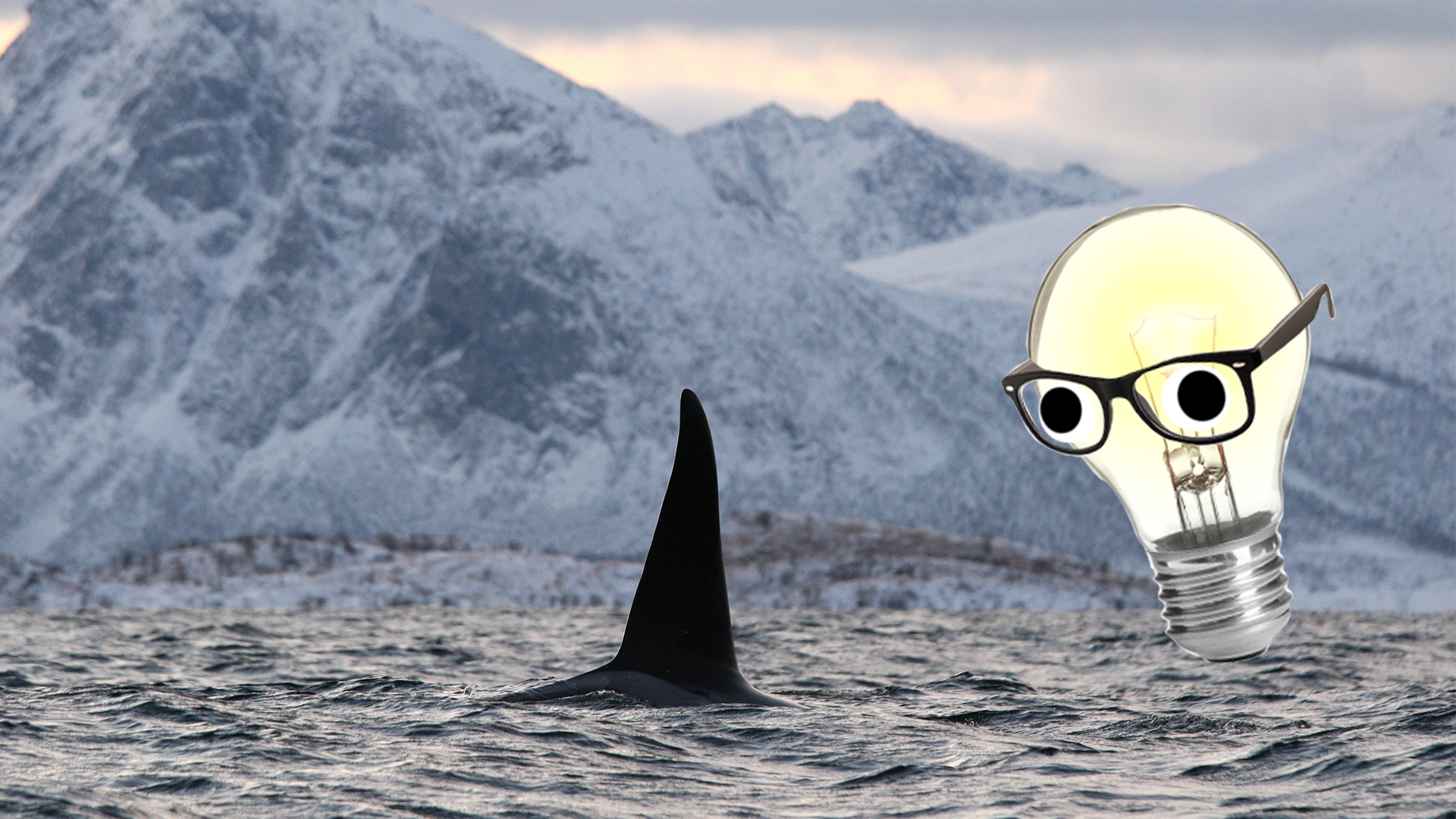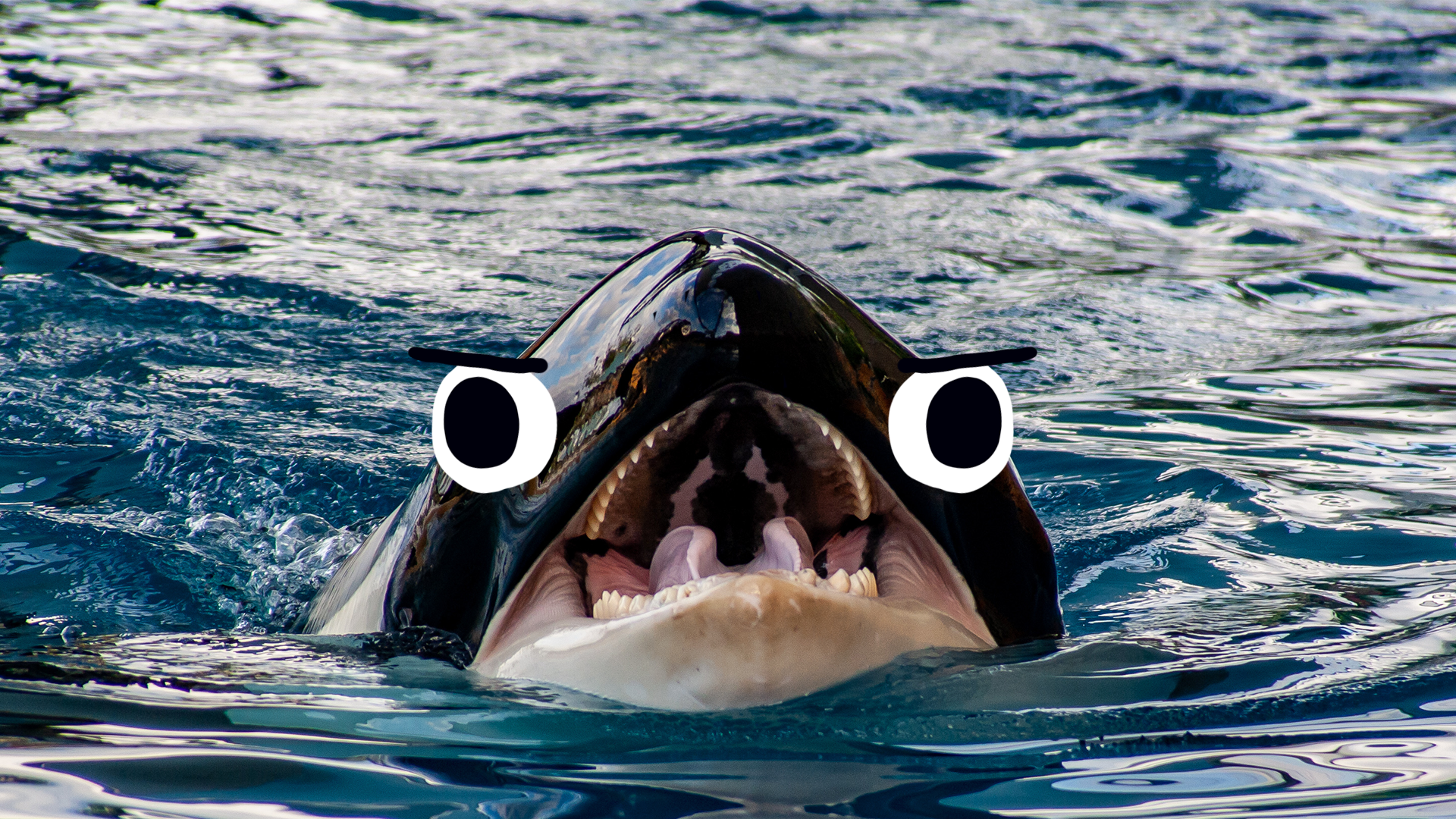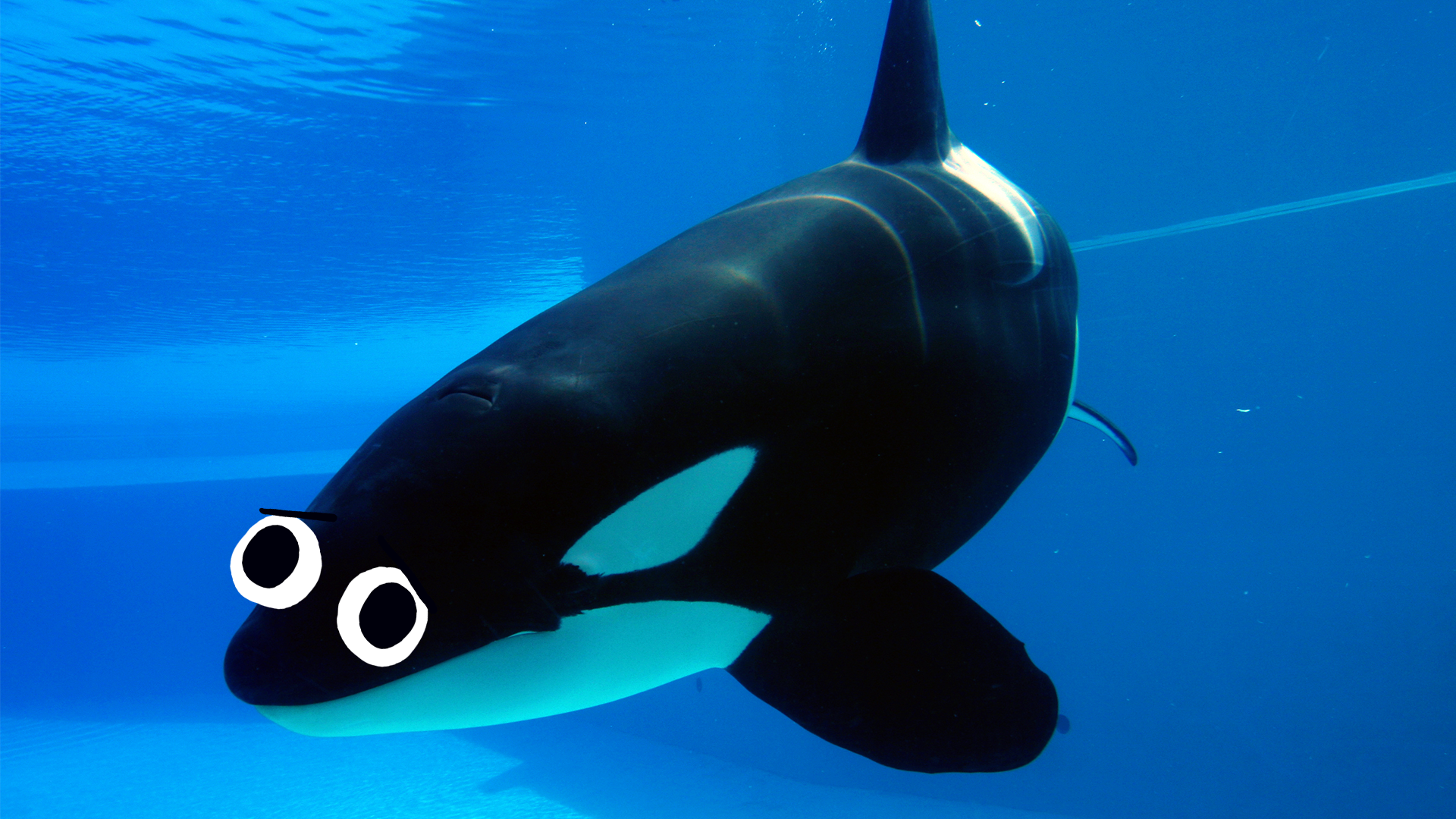15 Killer Orca Facts!
These facts aren't just black and white! Get ready to learn all about these fascinating marine mammals!
Orcas, also known as killer whales, are truly some of the most amazing creatures we share the planet with. They're big, they live a long time (up to 80 or 90 years!), and they're seriously cool looking! We're willing to bet there's plenty you don't know about these not-so-gentle giants - do you know what they like to eat, how they interact with humans - and why it's not a good idea to keep them in captivity? Let's dive in and find out!
And while you're here, learn more amazing animal facts with us! Why not discover everything about amazing Antarctic animals? Or black panthers? Or even ladybirds!
1. They're not really whales

Orcas are also known as killer whales, but they're not actually whales. They're really the largest members of the dolphin family! Both whales and dolphins are cetaceans, large aquatic mammals who exclusively eat other animals.
2. They are LARGE

They might not be as big as some of the bigger whales, but orcas are still pretty hefty! Males are usually bigger than females, and are usually about 6 to 8 metres long and weigh about 6 tons (6000kg), if not more! The biggest orcas ever documented have been about 10 metres long and 10 tons in weight!
3. They have large fins

Of course, an orca's most distinctive feature is its beautiful black and white pigmentation, but their tall fins come in at a very close second! The male orca's dorsal fin (the one on its back) can be up to 1.8 metres in height! That's the largest of all cetaceans, including the giant blue whale! The big fin keeps them stable in the water and means they can swim very fast (though it also means they're not great at making sharp turns). A healthy orca will have an upright fin, while a sick orca may have a collapsed fin (more on THAT later).
4. The name "killer whale" isn't quite what you think!

Killer whale sounds like a whale who kills a lot, and orcas do live up to that reputation. But the name actually comes from ancient sailors, who observed them preying on larger whales - so, "whale killer" might be more accurate! The common name "orca" comes from Orcus, the Roman god of the underworld, and references their deadly hunting ability.
5. They're very smart

Here's a fun fact about brains: intelligence isn't indicated by how big an animal's brain is. If that was true, then the world would be ruled by sperm whales (whose brains weigh up to 9kg)! Instead it's usually indicated by how complex a brain is - that is, how much surface area it has. That's why our brains are so wrinkly looking - they have a lot of surface area, which fits in lots of complex neurons. Killer whales have big brains that are also fairly complex, and so their intelligence is really remarkable to witness. There are lots of ways they demonstrate their intelligence (and some of them will be explained more later), including the fact that they have friends (members of their pod they seem to be closer to than others), they're been observed grieving dead orcas, and they can be trained.
6. They live in every ocean!

If you want to spot an orca, you're in luck - they can be sighted in every ocean in the world! You can go on boat trips near Antarctica, Alaska, Norway, Argentina, Australia, New Zealand, Iceland, Canada, France, South Africa and Japan, and be in with a chance of spotting an orca. It's always good to check out the best seasons and weather conditions for spotting them before you set out, and many local wildlife trusts can give you the best times to go orca-spotting. In the UK, your best chance is to go to the West and North of Scotland in the summertime.
7. They're masters of disguise

That black and white pigmentation isn't just there to look pretty - it actually helps the orca as it hunts for dinner! The black upper part means that the orca is hard to spot from above, blending into the dark ocean waves so they're invisible to seals resting on the land above. Their white underside means that they're invisible to creatures swimming below, as they blend into sunlight coming through the ocean's surface. This makes them deadly and effective predators. There are some variations across the world - for example, Antarctic whales might have paler grey backs to help them blend into the sea ice.
8. They're generally not dangerous to humans...

"Killer whale" sounds like a name to run away from really fast - but you actually don't have much to fear from killer whales. There have been a few confirmed attacks by wild orcas on humans, but none have been fatal, and it's generally thought that they happened because the orca mistook the human for an animal it wanted to eat (usually a seal). For example, in the early 1910s an orca tried to tip the sea ice with a photographer and a sled dog team on it - but this is probably because the whale thought that the dogs' barking was the noise made by a group of seals. In fact, there are a lot of accounts of orcas working with humans, usually to help them catch whales (and then swooping in to get a few bites off the catch). In several cultures, like the Ainu people of Japan, the Siberian Yupik, and the Indigenous tribes of the American Pacific Northwest, orcas are sacred creatures who are revered in art and mythology. You might remember reports of orcas ramming yachts, but scientists think this is either them joining in on a fad (more on that later!), or reacting from trauma of seeing their family injured by other boats - not because they want to hurt the people on board. You should always be careful when you approach any wild animal, but unless you're wearing a seal onesie, you're probably okay to go on a whalewatching cruise!
9. ...but they don't take well to captivity

There are a lot of attractions and theme parks where you can see sea mammals perform, and orcas have long been popular in these shows. But a captive environment is not a good place for a whale to live. Captive orcas live in environments that do not provide them with the enrichment they need. They are often kept in tiny tanks that don't match the space they need in the wild, and sometimes with orcas that aren't part of their pod and don't speak their language (which leads to fighting). There are also well-documented incidents of poor health in captive orcas, including pneumonia, short lifespans, fin collapse (which is when the dorsal fin goes floppy due to lack of proper nourishment) and dental damage from chewing on bars out of boredom. Because of that complex brain we've already talked about, orcas can develop mental issues like depression and aggression - towards other whales, and to humans. They also have to perform tricks that aren't part of their natural behaviour. While there are no recorded cases of wild orcas killing humans, there are four cases of captive orcas killing people, and injuring many more. Three of those killings were by the same orca, a male named Tillikum. A 2013 documentary, Blackfish, covered Tillikum's acts of violence and the general plight of captive orcas. It was so effective that it did serious damage to the reputation and income of SeaWorld, the theme park company that owned Tillikum. SeaWorld promised to end its orca breeding program, but as of 2024 there are still orca shows at the parks.
10. They love teamwork

They say it makes the dream work, and for orcas that's definitely the case! They are very social creatures, and live in pods that have a distinct language and culture. Orcas love to hunt together, and they have ways of capturing their food that rely on several orcas working in harmony. One example of this is tipping, where orcas will tilt sea ice to bring seals and other prey directly into their mouths. They also work together to herd fish into a small area so they can gobble them up more easily, and will work together when they want to take down a much bigger animal, like the blue whale. They're nicknamed "wolves of the sea" because they like to hunt in packs. Indeed, the Siberian Yupik people thought that wolves and orcas were the same animals, and that they transformed with the seasons! They also work together to raise and protect their young, with older females who can't have any more calves acting like grandmothers to all the young whales.
11. They have a very varied diet

Orcas are apex predators, which means that they themselves don't have any natural predators. The ocean is their buffet, then, when it comes to picking what's for supper! Orcas eat everything, from marine mammals (including whales MUCH bigger than them) to birds, including penguins and seabirds, and even sea turtles. They have to eat about 4% of their own body weight every day. They have about 45 pointy teeth, which are great for ripping and tearing their prey, but they don't often chew their food. Instead they prefer to eat it in one big gulp - they often swallow smaller prey whole!
12. They're very chatty

We've learned that whales have friends, live in groups, and love to hunt together, so it makes sense they also love to chat! Orcas make a lot of noises, including clicks, whistles, squeaks, screams, and pulses. Individual pods have their own languages, just like individual cultures and societies for humans - and they also have different dialects and accents! Orcas can't smell, but they have a better way of finding their way around - making noise! This is called echolocation, and it means they use their vocalisations to sense objects and prey in the water.
13. We can tell them apart!

Like many animals, orcas look the same from a distance - but if you look closer, you'll be able to tell them apart! Different whales have distinctive dorsal fins and saddle patches (lighter patches just behind their dorsal fins). That's useful for scientists trying to observe whale lifefspans and behaviour in the wild.
14. They have memes

Now this is fascinating! Wild orcas have been recorded performing certain behaviours in their pods. Sometimes scientists call these "fads", but honestly? They're pretty meme-like! One example of this happened in the 1980s, when a pod of orcas in the Pacific went through a phase of wearing dead salmon on their heads. A couple of other pods also picked up this behaviour. They stopped doing it after a couple of months, like a short-lived trend. Why? No one quite knows - maybe they thought it looked cool, or maybe they thought it was funny! Male orcas in British Columbia were also once observed playing a game by moving around fisherman's prawn and crab traps, even though they don't usually eat prawns or crabs. They stopped doing it quite quickly again, and scientists think it was a game - they were being mad lads! The boat-ramming we already mentioned might also be another example of a short-lived game. But what does this mean? Well first of all, it means that orcas would absolutely kill it on social media, if they could type. But most importantly, it means that they have their own cultures which evolve over time - something that we used to think only humans could do!
15. They're threatened

As with many animals, the beautiful orca is at risk from human activity. This doesn't just apply to the captive orcas, though - wild ones are also suffering from human activity. Manmade objects like boats interfere with their echolocation, which is bad for their feeding and their socialisation. Fishing is also a threat, with overfishing affecting their food supply, and fishing nets and boats injuring orcas in the wild. Pollution like toxic spills and plastic waste is also bad for them, as they consume things that aren't good for them. And of course, climate change is damaging their environments and threatening their food. What can you do? It's a good idea to join a wildlife conservation group, and do what you can to raise awareness of these wonderful creatures and their needs.



















